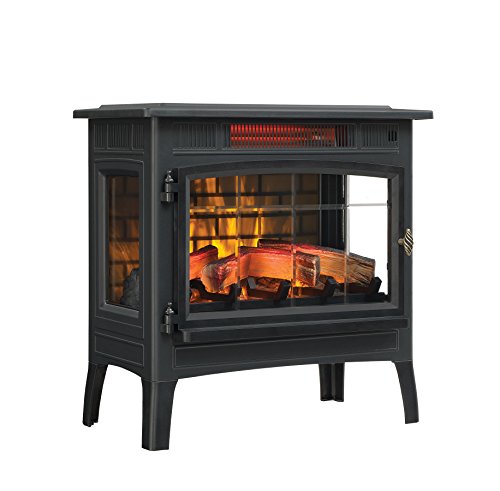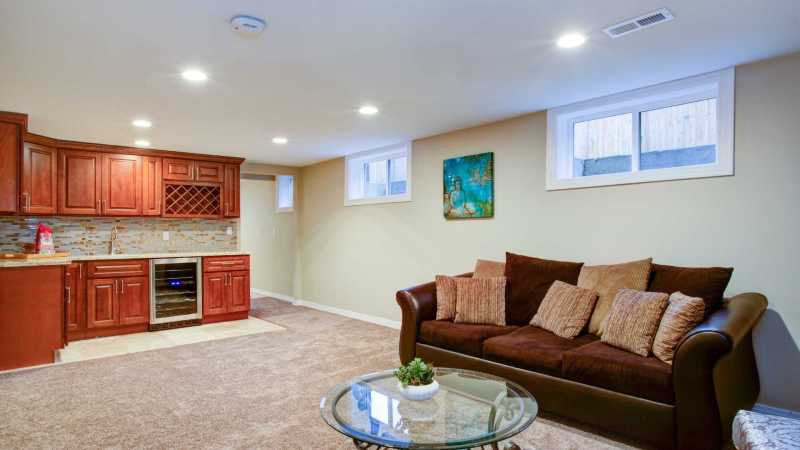A basement doesn’t have to be a cold, damp, dark place. If you have big dreams for your underground workshop, below-grade home gym, or basement guest room, you’ll need it warm and cozy down there.
Luckily, with the best space heater for your basement, you can achieve just that and build yourself a wonderful space you’ll love spending time in. Let’s take a look at our Top 3 picks, other recommendations, and a detailed buyer’s guide giving you everything you need to know to make the right purchase!
Top 3 Picks

- Oustanding whole room heater
- Combined Fan and Heater
- Great safety features

- Beautiful fireplace design
- Rated for up to 1000 square feet
- Remote control
Table of Contents
- Top 3 Picks
- We Also Recommend
- Best Space Heaters for Basement Reviews
- Buyer’s Guide
- Frequently Asked Questions
- Conclusion
We Also Recommend
- Best Cabinet: Duraflame Infrared Quartz Heater
- Best Panel: Wexstar WS-8WUS Infrared Panel Heater
- Best Tower: Lasko 5586 Digital Ceramic Tower Heater
- Best Heavy Duty: NewAir G73 Hardwired Electric Heater
- Best Floor Heater: SunTouch Mat Floor Heat Kit
These recommendations are tailored to the unique needs of a basement. If you find yourself needing a heater upstairs, check out the best space heaters for large rooms!
I’m confident you will find what you’re looking for so let’s get started with our product reviews.
Best Space Heaters for Basement Reviews

The space heater market is saturated with many models using a variety of technologies. It’s no wonder that it’s so easy to get lost in the plethora of choices. Don’t worry – our buyer’s guide (below) will walk you through all the details.
In the next section, I’ll give you reviews of the best finds on the market. I’ll include different types of space heaters and heating systems, and hopefully one of those will be just perfect for your basement.
We picked the best overall space heater based on two main features - the ability to heat the room quickly while doing it safely. Lasko is a trusted brand with a reputation for great products. The FH500 will warm up your basement fast with its 1500 watt ceramic heater.
Offering 3 speeds and 4 fans, not only is this product great in the winter, but the combo fan will also keep you cool in the summer. Standing tall and slim at 42 inches, this oscillating heater will distribute warm air efficiently while taking up minimal space.
It offers phenomenal built-in safety features, and it’s backed by a 3-year limited warranty!
Here’s what I like:
- Quick, powerful heater with an 8-hour programmable timer
- Easy to use control panel & digital thermostat
- Tip-over safety switch & overheat protection
The bad sides:
- LED lights can be bright at night
Specifications:
- Technology: Ceramic / Convective
- Dimensions: 12.5 x 12.5 x 14.88 inches
- Weight: 12.5 pounds
A space heater doesn't have to be an eyesore. Case in point, this infrared fireplace made by Duraflame rocks a beautiful, classy design that can enrich any decor. In fact, it even has a pretty realistic 3D flame effect, making winter nights cozier than ever.
Apart from beauty, this space heater comes with great power too. With an output of 5200 BTU, it can warm up spaces up to 1000 square feet. It can be controlled remotely.
Here’s what I like:
- Classy fireplace design with 3D flames
- Can warm up as much as 1000 square feet
- Comes with a remote control
The bad sides:
- The remote feels somewhat flimsy
Specifications:
- Technology: Infrared Fireplace
- Dimensions (LWH): 13 x 24 x 23.4 inches
- Weight: 29 pounds
There aren't many affordable heaters out there that are built to last - but this model by Homeleader proves they do exist. This little heater is small but it packs up quite a punch.
It comes with two heat settings at 1250 and 1500 watts. The infrared-based heater is equipped with a fan that helps spread warmth evenly across your basement. It's lightweight, yet made of sturdy steel, and very stable mounted on its two feet.
Here’s what I like:
- Small steel frame and a low-profile design
- Two heat settings: 1250 and 1500 watts
- Fan forced radiant heater
The bad sides:
- Quite small so it can’t heat up a big basement on its own
Specifications:
- Technology: Infrared with a fan
- Dimensions (LWH): 18 x 5.5 x 11 inches
- Weight: 5 pounds
Cabinet-design infrared heaters are becoming more popular by the day. These don't only heat up your basement rather efficiently, but they look elegant too. Set inside a pretty wooden box and mounted on high-quality caster wheels, this portable heater will make a nice addition to any living space.
This cabinet infrared heater is quite simple and easy to use. Its 5200 BTU power is controlled via an internal thermostat and a very simple control panel on the unit or remote control.
Here’s what I like:
- Elegant cabinet design
- Big but portable space heater due to caster wheels
- Easy-to-use control panel and remote control
The bad sides:
- The caster wheels may leave marks on hardwood floors
Specifications:
- Technology: Infrared with a fan
- Dimensions (LWH): 13 x 17 x 15 inches
- Weight: 26 pounds
Radiant heating doesn't only come in a traditional space heater form - it can also be subtly installed on a stylish white, thin panel.
You can install the Wexstar infrared panels on your wall or even on your ceiling. That's handy since the heater can't tip over or have cloth accidentally cover it, wreaking havoc. It radiates pleasant warmth without making a sound. One of these panels is ideal for 250 square feet. There are no heat settings, it's just "plug and play" - it uses 1500 watts.
This is one of the most energy-efficient heaters we feature. Using infrared technology to heat up the objects in the room, it may take a bit longer, but it's warm and efficient!
Here’s what I like:
- Mountable on the ceiling or the wall
- 1500-watt panel for 250 square feet
- Energy Efficient
The bad sides:
- No thermostat or heat control, just on/off
Specifications:
- Technology: Infrared panel
- Dimensions (LWH): 23.5 x 47 x 1 inches
- Weight: 16 pounds
A reliable tower heater can make any basement cozier and more inviting. This convection ceramic space heater model made by Lasko is a great 1500-watt choice.
Control it via the control panel or the included remote control. It comes with many different settings, including a low 900 and high 1500-watt heat output, and a timer that turns the machine off after up to 8 hours. The powerful fan of this convection heater also oscillates, making sure heat is evenly spread throughout the room.
Here’s what I like:
- Two heat settings
- 8-hour times
- Remote control
The bad sides:
- Slightly slower to heat a given area
Specifications:
- Technology: Convective
- Dimensions (LWH): 10.5 x 9 x 29.5 inches
- Weight: 7 pounds
If you're looking for some serious heat, and have an electricity line that can handle a 5000-watt space heater, this NewAir workshop heater is the way to go. This powerful forced air heater will warm up a 500 sq ft basement in no time.
It can be mounted on the wall or the ceiling, and it has a rugged powder-coated steel build. However, you'll need to have a professional install it since this powerful unit isn't a "plug and play" heater - it needs to be hardwired.
Here’s what I like:
- Heavy-duty workshop space heater
- Uses 5000 watts for serious heat output
- Rugged powder-coated steel build
The bad sides:
- Needs to be hardwired, can’t be simply plugged in
Specifications:
- Technology: Convective
- Dimensions (LWH): 9 x 9.5 x 14 inches
- Weight: 15 pounds
While this is not a space heater, we always like to present an "out of the box" solution to your home needs. Installing a floor heating system is one of the best heating methods for basements. This system should be installed under the top layer of the floor, so installation takes quite a bit of money, time, and effort. However, due to the fact that heat rises, installing a floor heating system is the most effective way to warm up your basement and a true long-term solution.
This particular floor heat kit by SunTouch comes in a variety of sizes. It includes the mesh material and heating unit, a touchscreen thermostat, floor sensor, and accessories for the installation.
Here’s what I like:
- Includes everything you need to install a floor heating system
- Touchscreen thermostat
- Comes in a variety of sizes
The bad sides:
- Requires a complex, expensive, and lengthy installation
Specifications:
- Technology: Floor heating system
- Dimensions: 2 x 5 feet or bigger
- Weight: 4 pounds
Buyer’s Guide

A home’s basement is often brushed off as merely a storage space. But in many cases, just leaving some old wheelbarrows and brooms down there is a waste of potential. Why ignore the underground portion of your house, when you can make your basement into a top-notch workshop, home office, guest room, gym, home cinema, or anything in between?
Why is Your Basement Colder than the Rest of the House?
A basement is so much different from the rest of the house because it’s below grade. Don’t worry – that doesn’t mean your basement is low quality, it just means it’s on and below ground level.
The Underground Effect
Your basement will always be a couple of degrees colder, even if it’s finished and insulated. In fact, unlike the above-grade rooms, insulation doesn’t do much for a basement at all: the ground around it provides sufficient lining to keep the temperature constant. It’s estimated that it takes around 2 months longer for the temperature in the basement to change than in above-grade rooms. That works both ways, keeping warmth in your basement well after summer ends. Sadly, due to their underground nature and small windows, basements rarely get enough sunlight to truly warm up.
The Effect of Humidity
Another common issue in basements is humidity – and it also plays a role in making you feel chilled to the bone. While the thermostat says it’s not that cold, a humid room always feels colder than it is. Because about 60% of all basements have a moisture problem, a bit of supplemental heat will help take the edge off.
Warm Air Goes Up
However, the main reason for heat loss in basements is not the walls or the floor – it’s the windows. Remember the Physics 101 principle: hot air rises while cold air stays down. The warmth from the basement goes up and out through the window, only to get replaced by the cold ground-level air from the outside. This is both bad and good news – while you need to make sure your basement windows are not drafty, a bit of supplemental basement heating will also keep your feet warm in the rooms above!
Concrete Everywhere
Concrete is a wonderful building material, but it has its disadvantages too. This porous material acts as a heat sink. That means that the material absorbs a lot of heat, and traps it in, making your room colder. Because of this trait, it’s a good idea to elevate your heater a couple of feet above the concrete floor, to avoid losing a significant portion of your heat in the material.

How Do I Choose the Best Heater?
How to Pick the Right Heater for your Home’s Basement
Whether you’re worried about your frozen pipes bursting or you want to keep your fingers comfy while working down there, getting a heater for your basement is a great investment. We feature eight different models, so knowing exactly what characteristics you need will ensure you choose the ideal option for you.
Types of Space Heaters for Basements
If you’ve been planning on doing some renovations, modifying your existing HVAC ductwork would be the perfect way to heat your basement. However, that’s expensive, and it takes a lot of work and patience. Here, I’ll tell you about the alternatives – sources of supplemental heat that will make your basement workshop, guest room, or gym cozy even during winter. We’ll discuss three types:
- Traditional Radiant Heaters
- Mica Thermic Heaters
- Oil-Filled Heaters
Radiant Space Heaters
If you’re searching for the most energy-efficient space heaters for your basement, radiant is the way to go. Most radiant space heaters use infrared technology, which is inexpensive, effective, and quiet.
A radiant (infrared) space heater is a great way to get cozy in your basement, even if it’s drafty. That’s because the basic variety of this type of heater doesn’t warm up the air. Instead, when the infrared radiation hits an object (or a person), it heats it. In turn, the objects warm up the room. This technology gives you instant warmth when you’re near the heater, but it doesn’t work well if there’s no furniture or objects in the room. Regular infrared heaters come in many forms, but the most popular types are fireplaces, towers, box-like cabinets, and wall and ceiling mountable infrared panels.
If you’re looking for something more traditional, you may opt for an infrared heater with a fan. These work similarly to traditional convection heaters. An infrared bulb warms up heat exchanging material, and a fan blows air to spread the air around the room.
The fact that this type of heater uses radiation makes many people feel uneasy, but there’s nothing to worry about. It’s been proven time and time again that infrared radiation can’t harm you or your pets. Just take general precautions as you would with any space heater, and you’ll be completely fine (and cozy)!
Mica Thermic Space Heaters
Though the technology is still quite new, mica thermic heaters are among the most efficient models on the market. In essence, mica is a mineral that has amazing thermal qualities. With only a tiny heating element in the center, the entire mica-filled device can heat up quickly and provide a lot of heat.
The advantage of mica thermic heaters is that their electromagnetic radiance spreads evenly throughout the room, warming up far and nearby objects at the same time.
A Word on Oil-filled and Convective Heaters
Convective space heaters are the good, old models that heat up with ceramic or metal elements and blow hot air around the room. On the other hand, oil-filled heaters typically look like regular radiators, and these use electricity to warm up the oil inside the device. Both of these technologies are great picks for regular rooms (unless they’re drafty).
Now that we’ve covered the different types of heaters, let’s take a look at the important features you need!
Basement Space Heater Features to Consider

Picking the right basement heater is far from easy. There are so many factors to consider and so many models out there on the market. That’s why I compiled this list of the most important features that any space heater needs to have to do a decent job.
Power in Wattage
If you need a basement heater, you should always go for an electric model. The reason why is simple – propane heaters let out fumes that can be dangerous in insufficiently ventilated areas.
The power of an electric space heater is measured in watts. In essence, that’s the amount of electricity it uses to generate heat. More power = more heat, so many electric basement space heaters have multiple power settings.
Room Size
Most powerful home-use (non-industrial) space heaters are rated at 1500 watts. If you’re using the heater as a supplemental heat source, a single heater can warm up a large basement area up to 700 square feet. However, if that is the only source of heat, you’ll need more than one device to warm up anything over 300 sq ft. Alternatively, you can opt for an industrial heater that uses more power, provided that your power line can handle it.
Portability
The unit’s portability depends on its size, weight, and power cord length.
Getting a heavyweight space heater into your basement might prove difficult, especially if you have a narrow staircase leading down. Don’t worry, small space heaters don’t necessarily create less heat – a fan heater can be a great option even if it’s just a few inches tall.
Keep in mind that you should never use an extension cord to power your space heater – always plug it in directly. These machines might be small, but they draw a lot of power.
Warmth Distribution
You want your basement to warm up as evenly as possible, especially if it’s large or you need to keep the heater far away from the place where you spend the most time. Heaters work in different ways, so their methods of delivering heat differ too.
Radiant infrared heaters heat the nearest objects, the fastest. That makes this heating method great for smaller rooms or basements where one part of the room is used more than others. However, mica thermic space heaters are a perfect workaround for this problem, since these radiant heaters heat every part of the room evenly.
A fan is there to push warm air out, and many kinds of heaters are equipped with one. Convective heaters (both ceramic and metal) always have a fan, and some infrared and mica thermic heaters do too.
Oscillation is another good way to ensure an even spread. It simply means that the heater rotates from one side to another while blowing hot air out. The best tower heaters will have both a fan and oscillation.
Safety Features
Don’t play with fire – get yourself a space heater with all the necessary safety features. There are two basic auto-shutdown safety features that every space heater should have: overheat protection and tip-over protection.
Most (but not all) space heaters are equipped with an internal or an external thermostat. This small addition makes it possible to track and set up the temperature you want. But it also plays an important role in keeping your home safe from fire hazards: for example, in case a piece of cloth accidentally covers the heater. Overheating protection makes sure the machine will automatically turn off when it reaches a specific critical temperature.
Tip-over protection shuts the device down if it falls over. This is a must-have feature for homes with small kids or pets, which can accidentally push the heater during playtime. It’s also a lifesaver if you live in an earthquake-prone area.
And last but not least – always read your space heater’s user manual to make sure you’re completely safe when using it.
Remote Control
When you get comfortable on your couch, the last thing you want to do is get up just to turn your space heater on or off. Fortunately, the new space heaters have remote controls.
Some smart heaters can even be voice-controlled through Amazon Alexa, or via a simple smartphone app. But in many cases, you get a separate remote control that lets you turn the heater on or off, and set up the temperature and work mode without getting up.
Floor Heating Systems
Installing a floor heating system takes more time, effort, and money to install, but it’s the ideal option for basements. Heat rises, so warming up your basement from the bottom is the best way to make both your toes and fingers comfy. Floor systems come in both electric and hydronic forms. In both cases, these are long tubes or wires that are fixed on a mesh material over the slab surface and covered with an upper floor layer. These make your feet feel fuzzy and warm, but it’s pretty expensive and labor-intensive to install.
Frequently Asked Questions
Do basement space heaters make your electric bill go up?
Well, yes – but the amount you need to pay depends on a couple of factors.
First of all, electricity costs differ by state. What you need to find out is how much money it costs per kilowatt-hour (kWh). This number tells you how much you pay if you use a 1000 watt machine for an hour.
Most regular-size electric space heaters use up to 1500 watts (or around 750 watts on lower settings). With this information, it’s not hard to calculate how much you would pay for an hour of heating.
The US average is about 14 cents per kWh. 1500 watts translates to 1.5 kilowatts (kW) – simply divide the watt number by 1000 to get kilowatts. Then, multiply the kW rating of your heater by the cost of electricity. In this example, 1.5 kW × 13 ¢ = 19.5 ¢ – so it takes 19.5 cents to run your heater for an hour.
For more information on this topic, check out our article on how much electricity your space heater uses here!
How can I heat my basement efficiently?
I’m not gonna lie – using electricity for heating can get expensive. Luckily, there are a few steps you can take to warm up your basement most efficiently.
If possible, use your space heater as a supplemental form of heating, not as a primary source. This can be achieved if you make revisions to your HVAC ductwork system. However, this is quite expensive to do, so it’s not realistic for everyone.
Cover your concrete walls and floors with another layer. Concrete acts as a heat sink, absorbing a lot of precious warmth. That’s why having another layer of sheet vinyl, tiles, epoxy, or any other flooring option in your basement will help reduce heat loss.
Weatherproof your windows. This is a huge factor – the majority of heat loss in basements happens up high – through the windows. The ground-level cold seeps in from the outside unless your windows are sealed tightly. Luckily, there’s a quick and easy fix for this: weatherstripping. You simply need to get a roll of self-adhesive weatherstrip at a local hardware shop and use it on your windows and doors.
Conclusion
Now that you’re equipped with the best space heaters on the market to serve your basement needs, and you understand all the important features you require. Please be sure to share this article and comment below.








